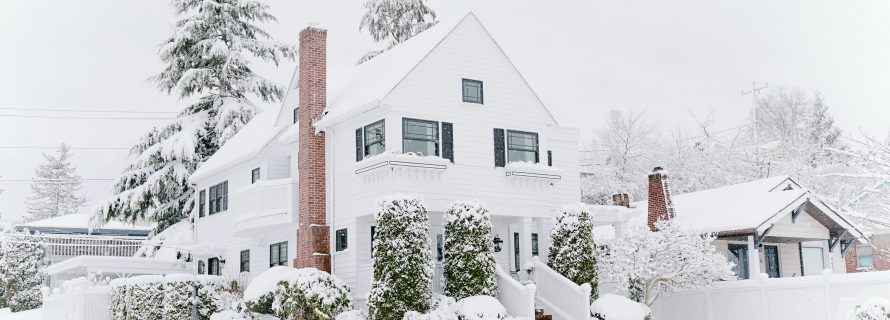Prepare Your Home’s Exterior and Yard for Winter Weather

Winter is, in many ways, a time of rest. We can’t go out as often as we do in the summer, and most life begins to hibernate, patiently waiting for the promise of spring. Working on your home in the winter is next to impossible, so it’s important to winterproof your property before the first snowfall. There’s a lot you can do to winterproof your home’s interior – you should at the very least schedule a furnace tune-up so you’re not literally caught in the cold – we’re going to focus on how you can winterproof from the outside in:
Patching Holes
Fall is the perfect time to take a thorough look at your home’s foundation and roof. Holes and broken shingles are a double whammy: they let the cold in and they let critters who are running from the cold in. What’s more, snow can make its way into those holes and melt, leading to moisture spots. Take the time to patch any holes and replace broken or warped shingles.
Now that we’ve talked about holes that aren’t supposed to be there, we should talk about the holes that are: namely vents, gutters, and downspouts. You want to clean your gutters of any leaves, and make sure they pour out at least five feet away from your home to avoid water pooling at your foundation. You should also cover any vents with mesh to dissuade critters from crawling in and making your home their home for the winter.
Waterproofing
Winter means snow and rain, and that means a lot of water. Water damage is insidious; it can wear away at your home for months without you noticing, creating a breeding ground for mold, all while damaging your home and increasing the risk of a house fire.
Paint is one of the most effective ways of waterproofing your home, so if you haven’t done so recently, side or paint your home’s exterior. Obviously that’s not going to be something you do every year, but there are some key elements of your home’s exterior you should check on every fall.
First, take a close look at the trim on your exterior facing doors and windows. You might notice that paint has started to chip or peel, or that the caulk is getting old and cracking. You should make the effort to repaint and recaulk these areas; it doesn’t take that much time, and it’s much easier than dealing with rotting trim.
Have a wooden deck, or any other kind of stained wood exterior structure? Take the time to drop some water onto it. When the water beads, you don’t have to do anything. Should the water get absorbed, on the other hand, you’re going to need to restain and seal it. Pay attention to stone surfaces too, which need sealing less regularly (but still occasionally).
Finally, you’ll want to take the time to waterproof your yard. Over time, your yard may shift and settle into low spots where water can pool. You’ll want to fill these low spots with soil so drainage is consistently sloping away from your home’s foundation, and water can’t pool.
Caring for Plants
Use fallen leaves from shrubs and trees as mulch for your garden, or check to see if your city has a composting program. You’ll also want to cover certain shrubs to keep them warm in the winter – not all breeds of shrub are meant to handle the cold.
Check your trees; dead trees are particularly susceptible to falling when they’re covered in snow. You might also take the time to trim any branches that are close to your or a neighbor’s home – having snow-covered branches smack against or falling into windows is an experience you want to avoid.
Dig up any flower bulbs you want to replant in the spring. Take any fragile plant pots indoors so they don’t crack over the winter.
Take the time to aerate and reseed your lawn, and apply a winterizing fertilizer. This is especially important if you didn’t aerate and reseed in the springtime – new growth can really only occur in the spring and fall.
Everything Else
Your garage and shed might be less-than-accessible in the winter, so take the time to use those tools! Fasten handrails, gutters, and anything else that needs fastening. Sweep your deck and porch. Rake up your lawn if you somehow hadn’t before aerating and reseeding it. Make sure your tools are accessible for when you decide to put winter tires on your car.
Move any tools that can rust into protected areas. Have salt readily available for your sidewalk and driveway. Sharpen ice choppers, put shovels in an easy accessible area, and tune-up your snow blower.
Make sure any external sources of water are completely drained and shut off. Wrap any external piping in insulating material.
With all of this, your house should be totally winterized! With all that work done, you’ve earned some rest over the cold season – make sure you’ve got plenty of blankets and hot cocoa.
About The Author: Kiara is a writer based in Canada. She writes articles with a focus on marketing and home improvement for a variety of businesses. Some of her favorite pieces can be found on the UV Pool’s website.
Photo by Tracy Adams on Unsplash
- Additions and New Construction
- All Exteriors
- Alterations
- Basements
- Bathrooms
- Customer Service
- Customer Stories
- Decks
- Design & Planning Show
- DIY
- Doors
- Educational Resources
- Extreme Makeover Home Edition
- Fashion Show
- General Remodeling
- Green Living
- Handyman Home Services
- Home Decor
- Home Entertainment
- Home Improvement
- Home Improvements
- How to Tips
- In The Community
- Kitchens
- Off-the-Wall Remodeling Stories
- Remodeling
- Resources
- Roofing
- Siding
- Social Media
- Sunrooms
- Tips & Tricks
- Trends
- Windows

